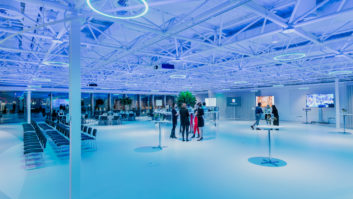According to forecasters over the last 100 or so years, 2020 will see all roads replaced by pneumatic tubes. Telepathy and teleportation will be possible. We’ll all have just one toe on each foot. The letters C, Q and X will no longer be part of the alphabet. Apes will be chauffeuring us around.
And those are just some or the more credible predictions. That said: in 1913, Gustav Bischoff had the honour of being more accurate than the majority of futurists when he foretold that, by 2020, our diet would consist mostly of vegetables.
Prognosticating about the future has, of course, made fools of some very wise people. But: that’s no reason not to try… What are the prospects for the AV industry in the next decade? How will it change over the coming 10 years? What technologies and concepts will become increasingly important – and which will have less influence?
Continuing growth
At the top level, Sean Wargo, who is senior director of market intelligence for AVIXA, sees no reason that growth in the industry will not continue. “Our forecasts for the five years to 2024 predict the industry will grow at a CAGR of 5.7%, rising from $247 billion globally to $325 billion. This is a faster growth rate than GDP during the same period,” he notes. “From where we sit now, I would expect similar growth to continue out to the full 10-year mark, thanks to the continuing wave of technology innovation and its use to address the needs of the ‘experience economy’.”
“The AV market is expected to witness consistent growth over the next decade,” echoes Claire Kerrison, senior market analyst professional displays at Futuresource. “Collaboration and connectivity will continue to drive revenues. Ecosystems and their interoperability – like the recent announcement of Microsoft Teams now working with Zoom and Cisco Webex – will remain a key aspect of AV hardware purchasing decisions both in the corporate and education spaces.”
Wargo too sees unified communications as a key AV market. “But,” he says, “we expect digital signage, which is currently the second largest, to eclipse it by 2024.”
For sure, markets, applications and technologies in any industry wax and wane over time. Among those forecast to wane – or at least, see structural changes – despite having at least held their own in the face of stiff competition from alternative technologies, is projection.
Solid state prevails
“Conventional projectors as we know them – based on lamp technology – will cease to be produced even in the commodity realms and solid state alternative light sources will prevail as the standard,” believes Frank Reynolds, who is European marketing manager at Antycip Simulation, noting environmental concerns as key drivers.
He has an ally in Jasmin Stemmler, product marketing manager, NEC Display Solutions Europe. “We expect to see lamp-based projection largely disappear over the coming decade in favour of laser as a light source,” she says. “Also, all projection below 5,000 lumens in brightness will decline.”
“Anything that isn’t connected and managed is likely to disappear”
Klas Dalbjörn, Powersoft
Rob Smith, senior director, integrated systems sales at Shure is broadly in agreement. “Projection within meeting rooms will probably continue to decline,” he adds, “as conventional screens become larger and cheaper and, for the largest applications, LED will increasingly become an option.”
That’s a view shared by Kerrison, who believes that it is the technology’s failure to readily integrate into collaboration solutions, among others, that are bringing about its decline. She does, however, see demand for high-brightness solutions remaining at least flat longer term as its inherent creative potential fails to be surpassed by any other display technology.
It is perhaps worth pointing out that the demise of projection has long been foretold. It remains, however, very much alive.
Boxes combine
So far as equipment is concerned, integration and connectivity seem likely to sound the death knell for some technologies and applications.
“I would expect more functions that are carried out by individual boxes in a system today to be combined, as Shure has achieved by bringing the IntelliMix DSP functionality on board the latest version of the MXA 910,” notes Smith. “This will reduce the complexity of systems and increase the capability of individual units within those systems.”
Klas Dalbjörn, product manager at Powersoft, sees things similarly. “Dumb, standalone analogue amplifiers will likely be replaced with managed solutions,” he avers. “Anything that isn’t connected and managed is likely to disappear.”
Martin Barbour, product manager, Q-SYS Cloud Software at QSC, outlines what he believes is the bigger picture. “Right now, the AV industry is mainly focused on piecing together disparate pieces of hardware and making them work as a cohesive system,” he says. “When an upgrade is needed, we tear out what’s there and rebuild from scratch, which costs the end user an exorbitant amount of money and time. This is where we think, as an industry, our value lies. In the next 10 years, our value will lie in how we bring software and hardware together. We’ll start to see an ecosystem approach to system design where a collection of products will be integrated in an intelligent way. Coupled with software, we can create a living platform that grows with the client over the lifetime of the product.”
www.antycipsimulation.com
www.avixa.org
www.futuresource-consulting.com
www.nec-display-solutions.com
www.powersoft-audio.com
www.qsc.com
www.shure.eu






